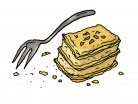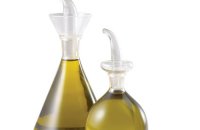When should I be concerned?
You should start to worry about the condition of your blood vessels if tests reveal any of the following:
- increased total cholesterol with normal levels of triglycerides
- increased total cholesterol with increased levels of triglycerides
- lowered HDL cholesterol
Cholesterol is classified either as high density (HDL), which is considered to be “good” cholesterol or as low density (LDL), which is considered to be “bad” cholesterol. HDL is cholesterol’s beneficial form because the higher its level, the lower the risk of heart disease, whereas the opposite holds true for LDL. Blood testing measures levels of total cholesterol, HDL and triglycerides. The LDL level is worked out via the HDL and triglyceride levels. Although they were recently found to be connected with cholesterol and heart conditions, triglycerides are also important lipids in the blood.
The effects
:
To calculate your daily cholesterol intake, please refer to the following measurements.
| Food |
mg of cholesterol per 100 gr
|
| Cereals |
0
|
| Olives |
0
|
| Vegetables |
0
|
| Nuts |
0
|
| Pulses |
0
|
| Alcohol |
0
|
| Fruit |
0
|
| Eggs |
400
|
| Cheese |
100
|
| Seafood |
100
|
| Commercial sauces |
95
|
| Red meat |
90
|
| Deli meats |
80
|
| White meat |
75
|
| Dairy products |
15
|
What else could be responsible for high cholesterol?
A number of factors could be at fault for high cholesterol and triglyceride levels. First, there are the reversible factors, that is, those that you have control over. These include smoking, weight, physical activity and stress. Then, there all those factors that are beyond our control, such as family history, personal history, age, and gender.
How are women at risk?
Because they generally have lower triglyceride levels and higher HDL levels than men, women run a lower risk of heart disease. After menopause, however, this changes; in fact, the risk of heart disease increases significantly with age for women. Women should be fully aware that their pre-menopausal lifestyle choices will significantly impact their risk of heart disease later in life. Generally speaking, when a woman’s triglyceride levels increase she is at a greater risk than a man showing the same levels.
Guidelines for controlling fats and lipids
The following guidelines have been published by the Organization for the Prevention of Cardiovascular Disease. These aim to reduce and control Category 1 risk factors contributing to increased lipids in the blood. That is, they aim to control smoking, improve physical condition and maintain healthy weight.
- Quit smoking. If you are unable to quit completely, reduce the amount that you smoke. Avoid passive smoking, or second-hand smoke.
- Exercise aerobically for at least 30 minutes 3-5 times a week. A passive lifestyle with little or no physical activity will cause high lipid levels later on in life. Exercise significantly increases HDL cholesterol and can lower total cholesterol by 10-15 units.
- Attain and then maintain a healthy body weight. In returning weight to normal levels, you lower your blood pressure and lower your blood glucose levels, while reducing lipids and raising HDL cholesterol levels.
Diet properly
When dieting, your daily calorie intake should be adjusted so that you lose weight slowly but steadily. Your aim must be to make a permanent lifestyle change, ensuring that the weight stays off. When planning a calorie-controlled diet, take into account age, gender, and level of physical activity. Aim for a balanced diet by ensuring that 15% of your daily food intake is in the form of protein, 30% fat and 55% carbohydrate. Diets of less than 1,500 calories a day are not recommended.
Meet your protein requirements by eating fish once a week, as well as poultry without the skin once a week. Consume red meat as well, but far less frequently, perhaps once every 10-15 days. Cut down on whole milk dairy products and have semi-skimmed or skimmed products instead, depending on the amount of weight you need to lose. Pulses are a very good source of protein and should be eaten 2-3 times a week. Beware of fats, avoiding all except for olive oil. As olive oil is a monounsaturated fat and has beneficial effects on blood lipid levels, you need not limit your olive oil consumption. Especially when dieting, your daily intake of saturated animal fats- cholesterol- should never exceed 300 mg a day. Cut down substantially on eggs and cheese.
The bulk of your diet should be made up of carbohydrates, mainly cereals, fruit and vegetables. Avoid sugar and sweets. Make sure you get enough fiber, as the substance is known to bind together fats and cholesterol in food, thereb y preventing their absorption by the body. Be careful about the amount of carbohydrates you eat. Stable blood glucose levels and the reduction of triglycerides depend mainly on your carbohydrate intake. Because salt, coffee, and alcohol are notoriously connected with high blood pressure, reduce your intake of these substances, apart from red and white wine. If you consume 1-2 glasses daily, wine can have a beneficial impact on cardiovascular functioning.
Helpful tips of dieting properly:
- Do not cook with wine or other types of alcohol. Wine should be served at the table, so that whoever wants to drink it knows exactly how much alcohol they have consumed.
- Do not add salt during cooking. Everyone can just add salt at the table.
- Bear in mind that smoked meats, fish, poultry, and cheese are high in salt, as well as fat. Therefore, consume such products in moderation.
- Never cook with butter. Olive oil will do.
- Forget about cream.
- Try replacing your usual sweets with healthy sweets year round.
- All sweets prepared with whole milk are just as satisfying when made with skimmed milk. The same is true for any sauce.
- Use skimmed milk in your coffee. One cup of coffee a day won’t have adverse affects on your health, but restrain yourself from more than two.
- Do not spread butter or margarine on bread. Try honey or jam instead.
- Cook red meat with vegetables and serve with extra salad at the table. The more fiber you take in, the less your body will absorb.
- Remove skin from poultry and trim fat as much as possible from your meat before cooking.
- If you must have red meat, eat pork. It contains less cholesterol than other varieties of red meat (100 gr of pork contains 72 mg of cholesterol whereas beef contains 89 mg).
- Use only the egg white when making sauces and not the yolk. If you want a thicker sauce, add a tablespoon of mashed potato to meringue, instead of egg yolk.
- Use only the egg white for crumbed dishes; discard the yolk.
- Remember that even if it comes from a partridge or an ostrich, all eggs contain cholesterol, even cod roe and caviar.
How am I supposed to remember all of this? Write this down:
- Normal levels are below 200 mg/dl (mg per 100 ml of blood)
- The desired level for HDL “good” cholesterol is 240 mg and over
- The desired level for LDL “bad” cholesterol is between 35 and 130 mg.
- A LDL level of over 160 mg is considered high risk.
Practical advice
| Cut down on… | Instead… |
| Whole eggs | Only the white |
| Cheese high in fat | Only cheese that is less than 10% fat (cottage, myzithra, soya) |
| Whole milk dairy products | Skimmed or semi-skimmed |
| Fruit juice | Fresh fruit, not peeled |
| Cooked, processed salads | Fresh green salads |
| Sauces and dressings | Vinegar or lemon |
| White bread | Whole grain bread |
| Bakery products made with white flour | Bakery products made with whole grain flour |
| Sweets high in fat | Lenten sweets, jellies, preserved fruit |
| Ice cream | Water-ice |
| Red meat | Pork, poultry and rabbit |
| Processed cereals | Those not processed |
| Hulled pulses | Whole pulses |
| Butter and cream | Only olive oil |
| Salted nuts | Unsalted, with the skin |
| Alcohol | Only wine |
| Pies and tarts | Vegetable pies |
| Coffee and soft drinks | Soda water and filtered |
Source: Vita


































































